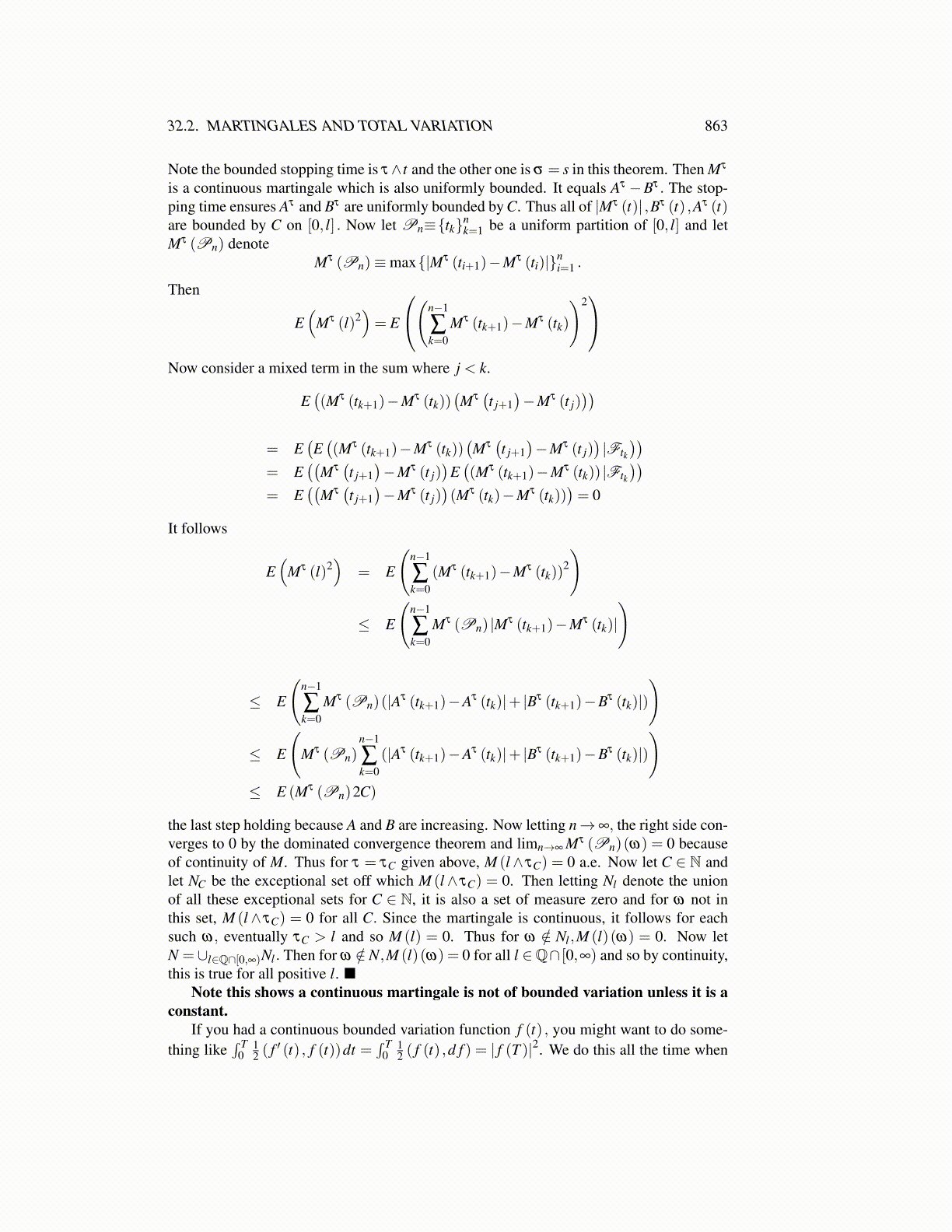
32.2. MARTINGALES AND TOTAL VARIATION 863
Note the bounded stopping time is τ∧t and the other one is σ = s in this theorem. Then Mτ
is a continuous martingale which is also uniformly bounded. It equals Aτ −Bτ . The stop-ping time ensures Aτ and Bτ are uniformly bounded by C. Thus all of |Mτ (t)| ,Bτ (t) ,Aτ (t)are bounded by C on [0, l] . Now let Pn≡{tk}n
k=1 be a uniform partition of [0, l] and letMτ (Pn) denote
Mτ (Pn)≡max{|Mτ (ti+1)−Mτ (ti)|}ni=1 .
Then
E(
Mτ (l)2)= E
(n−1
∑k=0
Mτ (tk+1)−Mτ (tk)
)2
Now consider a mixed term in the sum where j < k.
E((Mτ (tk+1)−Mτ (tk))
(Mτ(t j+1
)−Mτ (t j)
))= E
(E((Mτ (tk+1)−Mτ (tk))
(Mτ(t j+1
)−Mτ (t j)
)|Ftk
))= E
((Mτ(t j+1
)−Mτ (t j)
)E((Mτ (tk+1)−Mτ (tk)) |Ftk
))= E
((Mτ(t j+1
)−Mτ (t j)
)(Mτ (tk)−Mτ (tk))
)= 0
It follows
E(
Mτ (l)2)
= E
(n−1
∑k=0
(Mτ (tk+1)−Mτ (tk))2
)
≤ E
(n−1
∑k=0
Mτ (Pn) |Mτ (tk+1)−Mτ (tk)|)
≤ E
(n−1
∑k=0
Mτ (Pn)(|Aτ (tk+1)−Aτ (tk)|+ |Bτ (tk+1)−Bτ (tk)|)
)
≤ E
(Mτ (Pn)
n−1
∑k=0
(|Aτ (tk+1)−Aτ (tk)|+ |Bτ (tk+1)−Bτ (tk)|)
)≤ E (Mτ (Pn)2C)
the last step holding because A and B are increasing. Now letting n→∞, the right side con-verges to 0 by the dominated convergence theorem and limn→∞ Mτ (Pn)(ω) = 0 becauseof continuity of M. Thus for τ = τC given above, M (l∧ τC) = 0 a.e. Now let C ∈ N andlet NC be the exceptional set off which M (l∧ τC) = 0. Then letting Nl denote the unionof all these exceptional sets for C ∈ N, it is also a set of measure zero and for ω not inthis set, M (l∧ τC) = 0 for all C. Since the martingale is continuous, it follows for eachsuch ω, eventually τC > l and so M (l) = 0. Thus for ω /∈ Nl ,M (l)(ω) = 0. Now letN =∪l∈Q∩[0,∞)Nl . Then for ω /∈N,M (l)(ω) = 0 for all l ∈Q∩ [0,∞) and so by continuity,this is true for all positive l. ■
Note this shows a continuous martingale is not of bounded variation unless it is aconstant.
If you had a continuous bounded variation function f (t) , you might want to do some-thing like
∫ T0
12 ( f ′ (t) , f (t))dt =
∫ T0
12 ( f (t) ,d f ) = | f (T )|2. We do this all the time when